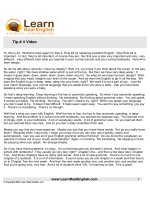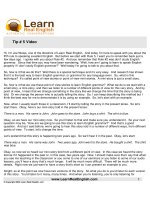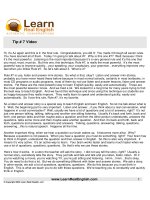Tài liệu học tiếng anh phần 5 theo phong cách diều hâu ?
Bạn đang xem bản rút gọn của tài liệu. Xem và tải ngay bản đầy đủ của tài liệu tại đây (67 KB, 2 trang )
Tip # 5 Video
www.LearnRealEnglish.com 1
© Copyright 2009: Learn Real English, LLC
Hi, I’m Joe Weiss, one of the directors of Learn Real English. And today I’m here to speak with you about the
fifth rule to speaking excellent English. But before we start with Rule 5, I want you to remember back just a
few days ago. I spoke with you about Rule #2. And you remember that Rule #2 was don’t study English
grammar. Since that time you may have been wondering, “Well, how am I going to learn to speak English
properly if I don’t study English grammar?” Well today I’m going to talk to you about that.
So, how is it that we do this? Well there is a special technique and it’s very easy. And research has shown
that it is the best way to learn English grammar, or grammar for any language even. So, what is this
technique? It’s called point of view stories or point of view mini-stories. A mini-story is just a small story.
So, how is it that we use these point of view stories to learn English grammar? What we do is we start with a
small story, a mini-story, and then we listen to a number of different points of view for this very story. And by
point of view, I mean that we change something in the story like we change the time that the story is being
told. Or we change the person who is actually telling the story. So, I can keep describing this method but I
think the best way for me to demonstrate it is by using an example. So, let’s start with an example.
Now, when I usually teach these in a classroom, I’ll start by telling the story in the present tense. So let’s
start there. Okay, here’s our mini-story told in the present tense:
There is a man. His name is John. John goes to the store. John buys a shirt. The shirt is blue.
Okay, so we have our mini-story now. So you’ll listen to that and make sure you understand it. So your next
question may be, “How are we going to use this story to learn English grammar?” And that’s a good
question. And as I said before, we’re going to hear this story told in a number of different ways, from different
points of view. To start, let’s change the time.
Let’s pretend that this story is happening two years ago. So we’ll hear it in the past. Okay, let’s start:
There was a man. His name was John. Two years ago, John went to the store. He bought a shirt. The shirt
was blue.
Okay, so now we’ve heard our mini-story told from a different point of view. In this case we heard the story
told as if it happened in the past or, in this case, two years ago. Now, I should make sure that I say that when
you see me teaching in the classroom or you come to one of our seminars or you listen to some of our audio
lessons, you’ll hear a story that’s much longer. It will be much more difficult. There will be much more
details. Right now we just want to have a story that’s short so I can present an example to you.
Alright, so at this point we now have two versions of the story. So what you do is you’d listen to each version
of this story. You’d listen to it many, many times. And when you’re listening, you’re only listening for
Tip # 5 Video
www.LearnRealEnglish.com 2
© Copyright 2009: Learn Real English, LLC
understanding. You just want to make sure that you understand the story. And as you do that you will be
learning grammar because the grammar is different in each one of these stories. But you don’t need to know
that. All you have to do is relax and listen to each one of the stories and make sure that you understand it.
We can also use another point of view for this story.
Let’s take a look at the story told, say, in the future, one year from now. So think one year from now.
Imagine, we’re one year from now. Okay, here is the story:
There will be a man. His name will be John. John will go to the store. John is going to buy a shirt. The shirt
will be blue.
Okay, so now we have three different versions of this same story. So you listen to each one. You listen to
them many times. You listen to the first one, which is the mini-story. You listen to the one that happened in
the past. You listen to the one that happens one year from now, or the one in the future. And you will begin
to see how each story changes. And you will only be listening to the story to make sure you understand it.
You will not be thinking about grammar. That’s not what you’re supposed to do. But you will be learning
grammar. We can even hear this story in one other point of view.
Let’s this time hear the story as if the main character, John, is telling the story himself. So here’s the story:
I am a man. My name is John. I go to the store. I buy a shirt. The shirt is blue.
So you can hear how the story has changed. Now, especially that we’ve heard four different versions of this
same story. So, of course, you would listen to each one of these stories. You’d listen to them many times.
And as you’re listening, you’re only listening for understanding. You’re not trying to remember what verb
tense the story is in or if there is an irregular version of one of the verbs that’s being used. No, no, no. We
don’t want you to think about any grammar rules like that. All you’re doing is you’re listening to the story for
understanding. And it’s easy and relaxing.
That’s why this technique is so easy and powerful…because you learn so many grammar rules without
having to study or memorize these grammar rules. They come to you automatically. As you’re listening, and
you listen for understanding, you learn the grammar automatically. And what that means is, when you go to
speak the grammar will automatically come to you. You won’t have to think about it. You won’t have to
analyze English. It will just come to you easily. You’ll be able to speak more confidently. People will be able
to hear how differently you sound when you speak. How much more correct you sound. How much more
confident you sound. And that’s what we really want.
Okay, so remember, Rule #5 is use point of view stories. They are a powerful method of using these stories
to actually learn grammar without having to memorize any grammar. Okay, that’s all for now. Thank you
very much and we’ll see you next time.









